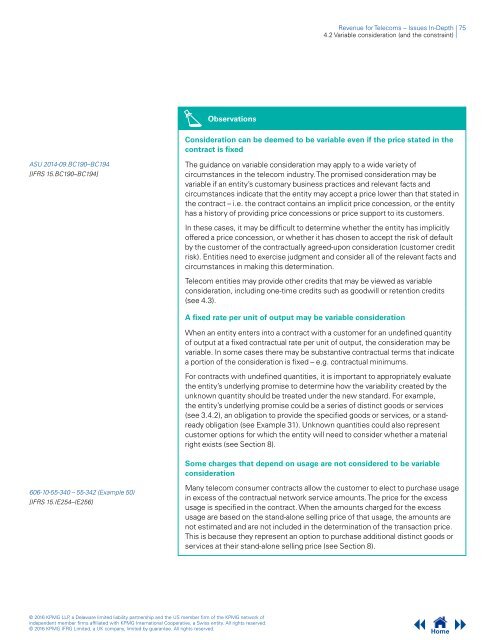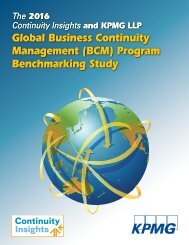Revenue for Telecoms
2cdncba
2cdncba
You also want an ePaper? Increase the reach of your titles
YUMPU automatically turns print PDFs into web optimized ePapers that Google loves.
<strong>Revenue</strong> <strong>for</strong> <strong>Telecoms</strong> – Issues In-Depth | 75<br />
4.2 Variable consideration (and the constraint) |<br />
Observations<br />
Consideration can be deemed to be variable even if the price stated in the<br />
contract is fixed<br />
ASU 2014-09.BC190–BC194<br />
[IFRS 15.BC190–BC194]<br />
The guidance on variable consideration may apply to a wide variety of<br />
circumstances in the telecom industry. The promised consideration may be<br />
variable if an entity’s customary business practices and relevant facts and<br />
circumstances indicate that the entity may accept a price lower than that stated in<br />
the contract – i.e. the contract contains an implicit price concession, or the entity<br />
has a history of providing price concessions or price support to its customers.<br />
In these cases, it may be difficult to determine whether the entity has implicitly<br />
offered a price concession, or whether it has chosen to accept the risk of default<br />
by the customer of the contractually agreed-upon consideration (customer credit<br />
risk). Entities need to exercise judgment and consider all of the relevant facts and<br />
circumstances in making this determination.<br />
Telecom entities may provide other credits that may be viewed as variable<br />
consideration, including one-time credits such as goodwill or retention credits<br />
(see 4.3).<br />
A fixed rate per unit of output may be variable consideration<br />
When an entity enters into a contract with a customer <strong>for</strong> an undefined quantity<br />
of output at a fixed contractual rate per unit of output, the consideration may be<br />
variable. In some cases there may be substantive contractual terms that indicate<br />
a portion of the consideration is fixed – e.g. contractual minimums.<br />
For contracts with undefined quantities, it is important to appropriately evaluate<br />
the entity’s underlying promise to determine how the variability created by the<br />
unknown quantity should be treated under the new standard. For example,<br />
the entity’s underlying promise could be a series of distinct goods or services<br />
(see 3.4.2), an obligation to provide the specified goods or services, or a standready<br />
obligation (see Example 31). Unknown quantities could also represent<br />
customer options <strong>for</strong> which the entity will need to consider whether a material<br />
right exists (see Section 8).<br />
Some charges that depend on usage are not considered to be variable<br />
consideration<br />
606-10-55-340 – 55-342 (Example 50)<br />
[IFRS 15.IE254–IE256]<br />
Many telecom consumer contracts allow the customer to elect to purchase usage<br />
in excess of the contractual network service amounts. The price <strong>for</strong> the excess<br />
usage is specified in the contract. When the amounts charged <strong>for</strong> the excess<br />
usage are based on the stand-alone selling price of that usage, the amounts are<br />
not estimated and are not included in the determination of the transaction price.<br />
This is because they represent an option to purchase additional distinct goods or<br />
services at their stand-alone selling price (see Section 8).<br />
© 2016 KPMG LLP, a Delaware limited liability partnership and the US member firm of the KPMG network of<br />
independent member firms affiliated with KPMG International Cooperative, a Swiss entity. All rights reserved.<br />
© 2016 KPMG IFRG Limited, a UK company, limited by guarantee. All rights reserved.<br />
Home







